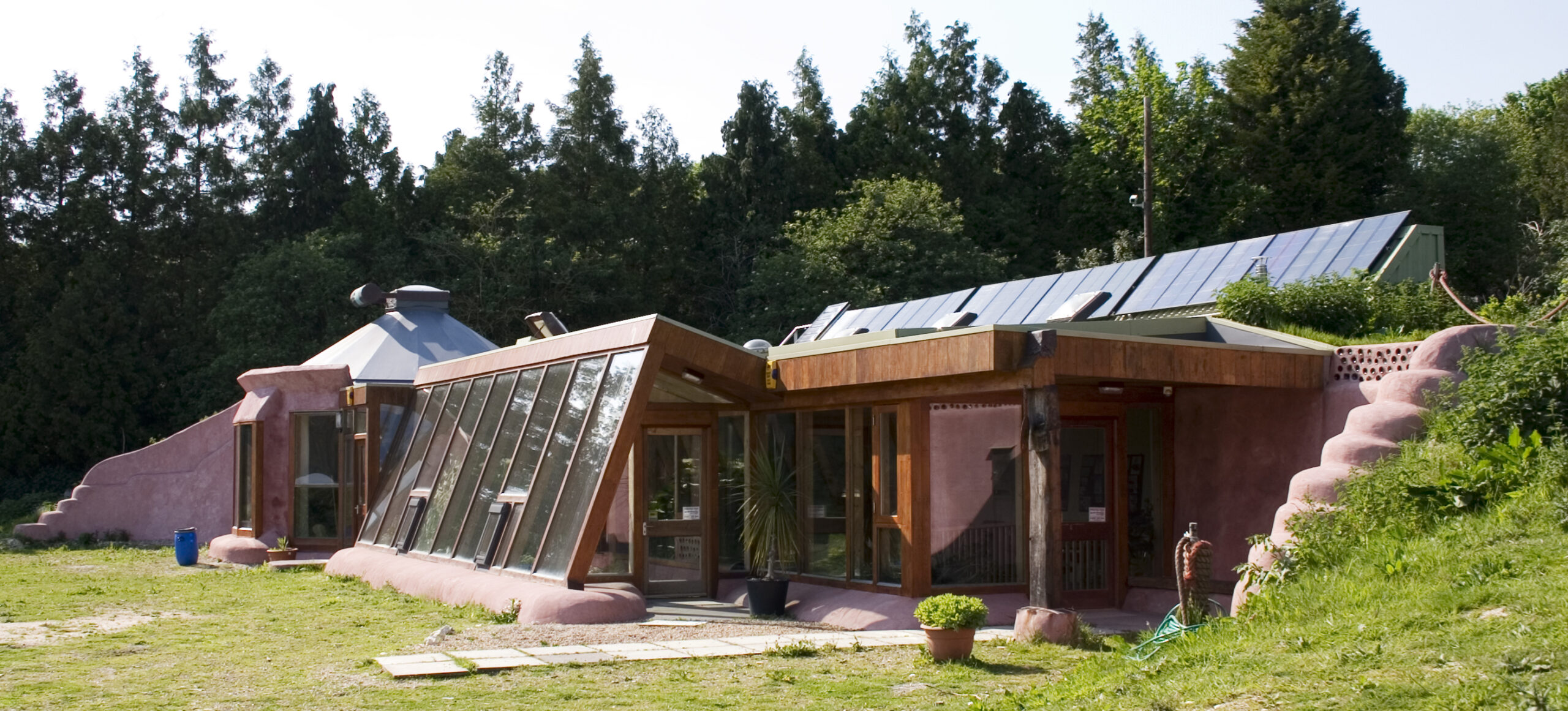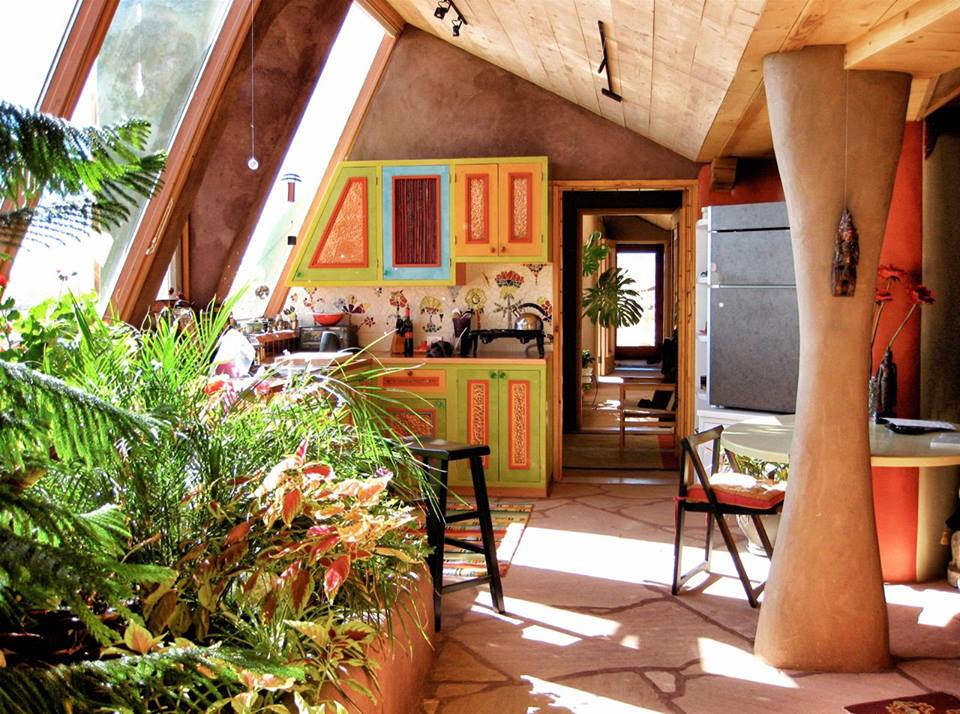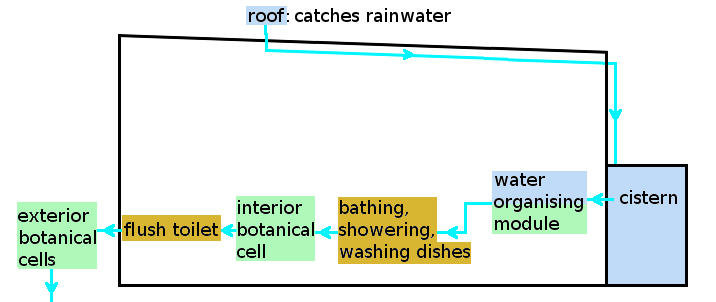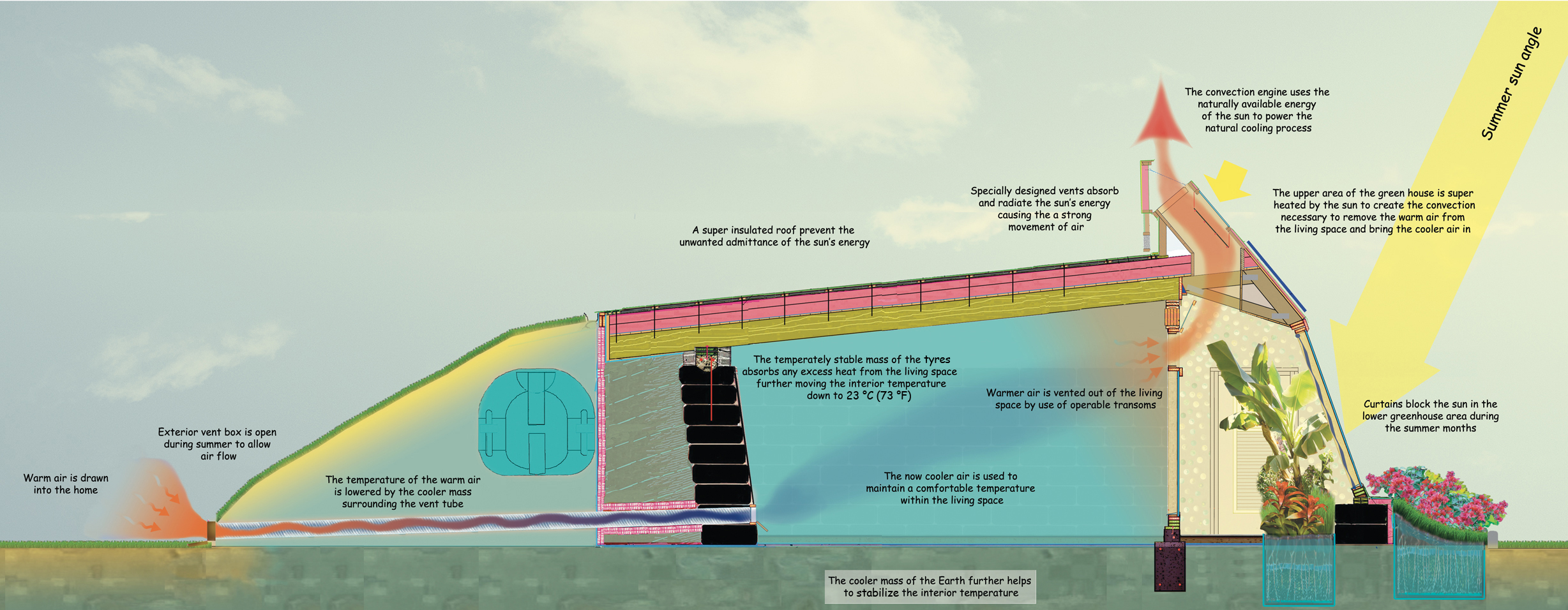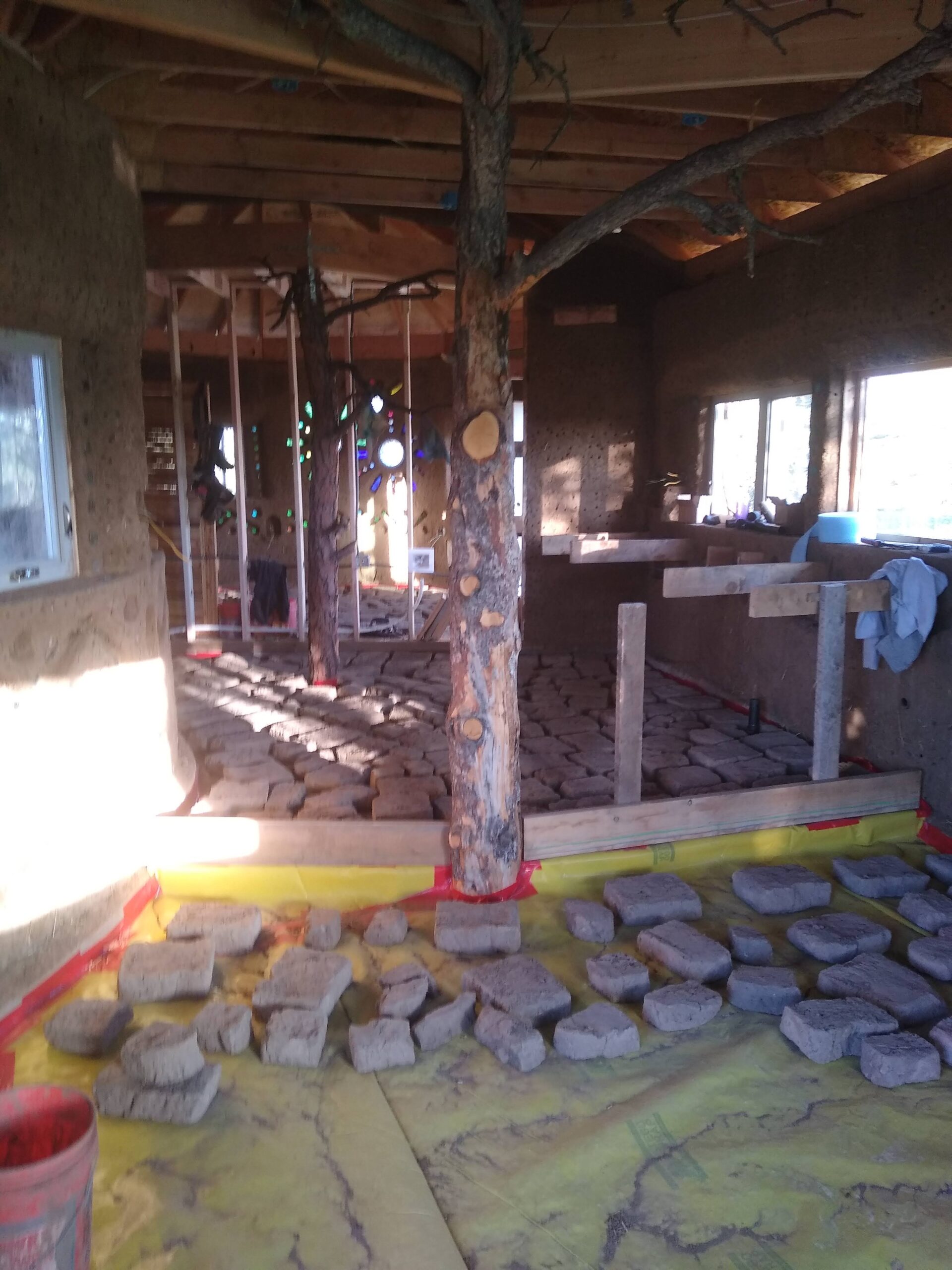Natural Building
Natural Building is a collective name for building technologies that rely mainly on natural materials and components. That is clay, sand, straw, wood, stone, lime and water. Some of those techniques are known as Adobe, Earth bags, Rammed Earth, Cob, Straw bale, Cord wood, Wattle & Daub, etc. These technologies have been developed hundreds or thousands of years ago, but today see a revival as we make more careful decisions about how we want to live and how much we want to impact our environment.
Natural Building Technologies
this is a brief overview of Natural Building technologies that we know of. Some of them you will get to know in our Natural Building Workshops.
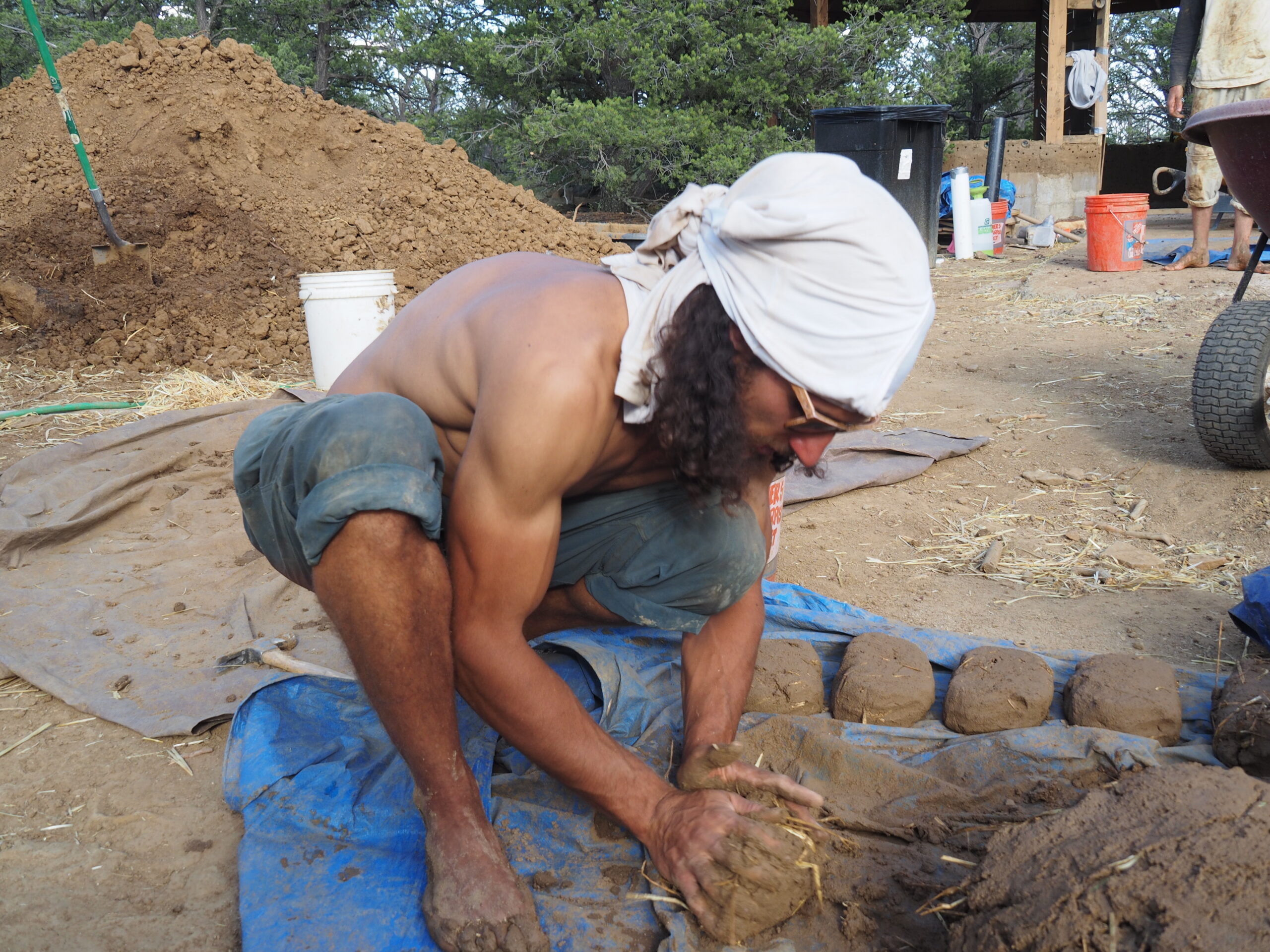
making cob loafs
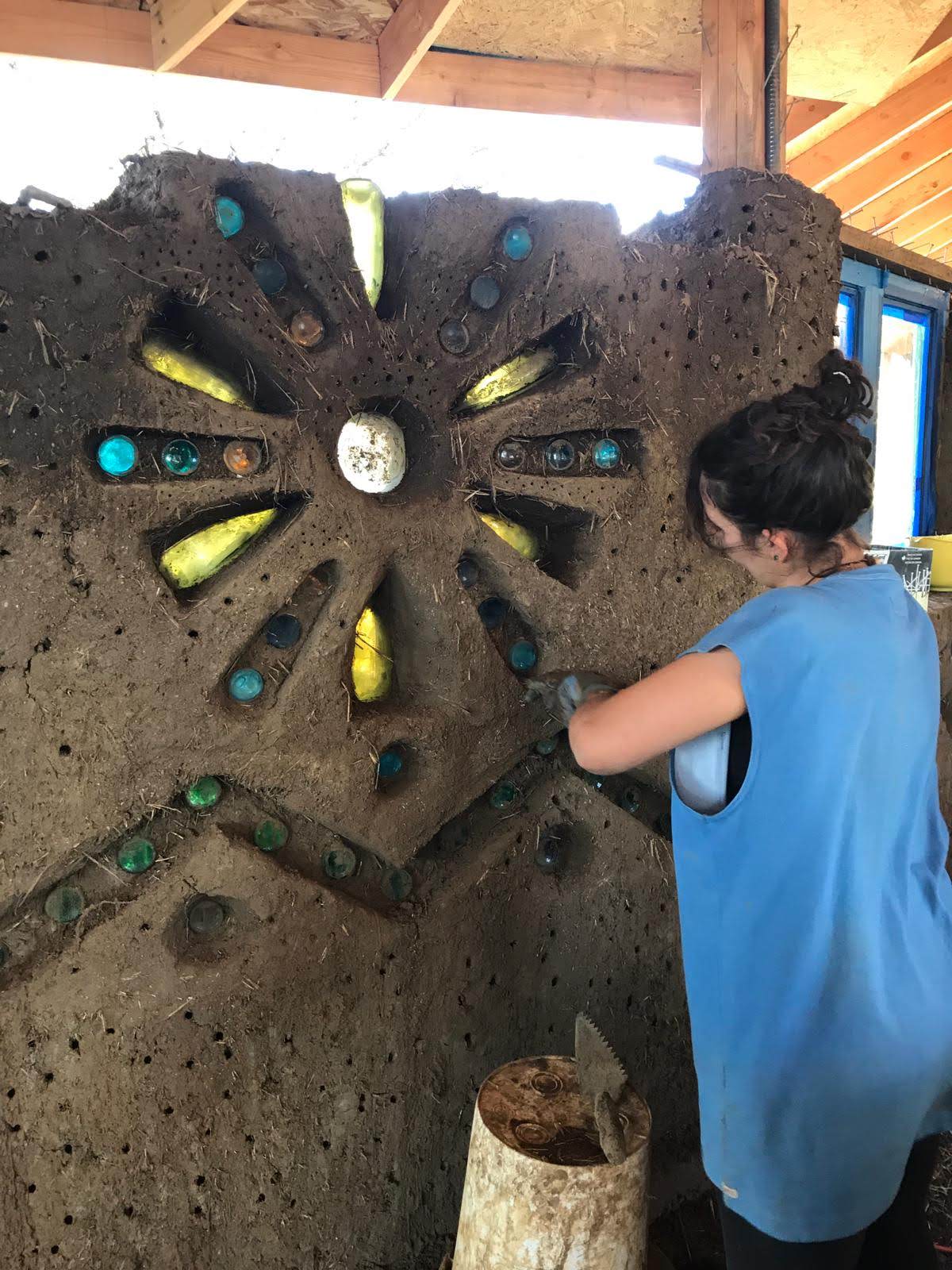
sculpting cob walls
Cob
‘Cob’ is a British expression for a loaf of bread which is the namesake for this building technique. A mix of clay, sand and straw is usually mixed barefoot on a tarp or in a pit, then formed into loafs. These loafs are merely formed for easier transportation to the wall, where they are applied and connected into the previous layer. This way the whole wall forms a monolith that is structurally enforced by the straw in it. This technique has been tested to be highly earthquake and fire resistant. It also has a high thermal mass, i.e. capacity to store heat over the day and release it by night. Therefore these earthen walls are often used in passive solar heated buildings.
Another feature of earthen walls is their ‘ability to breath’, that is permeability that allows for diffusion and evaporation of moisture. Through this they generate a comfortable indoor climate and protect from mold. The drying and curing process, compared to cement, is longer but more forgiving. This also allows for its unique property to sculpt curves, niches, arches, embed bottle bricks and create beautiful sculptures. Using abundant and non-processed materials makes it very cheap. The building process is easy, yet very labor intensive. Like most natural building technologies, it can be a cheap option for skillful do-it-yourselfers though.
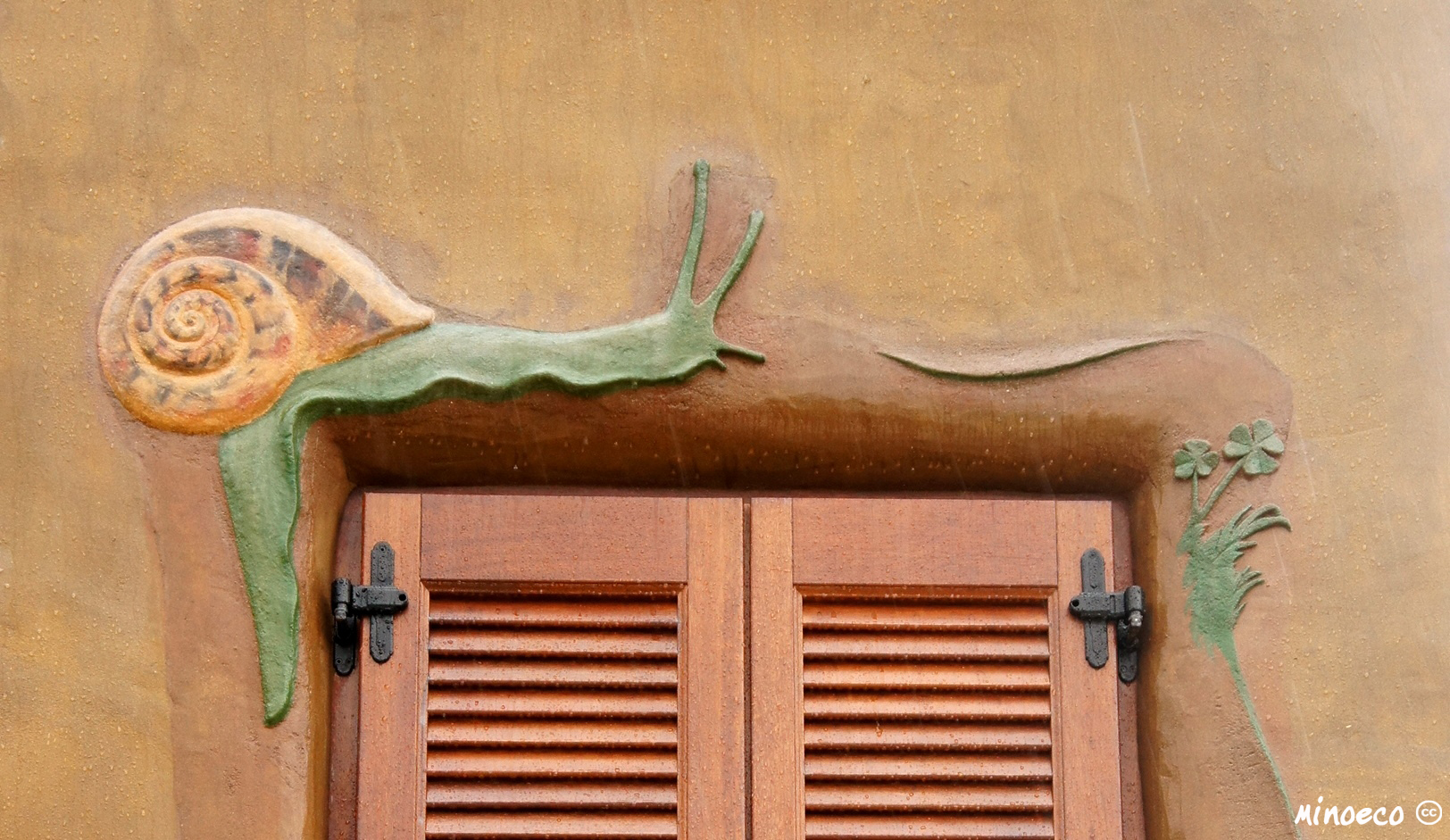
earthen plaster with linseed oil for waterproofing
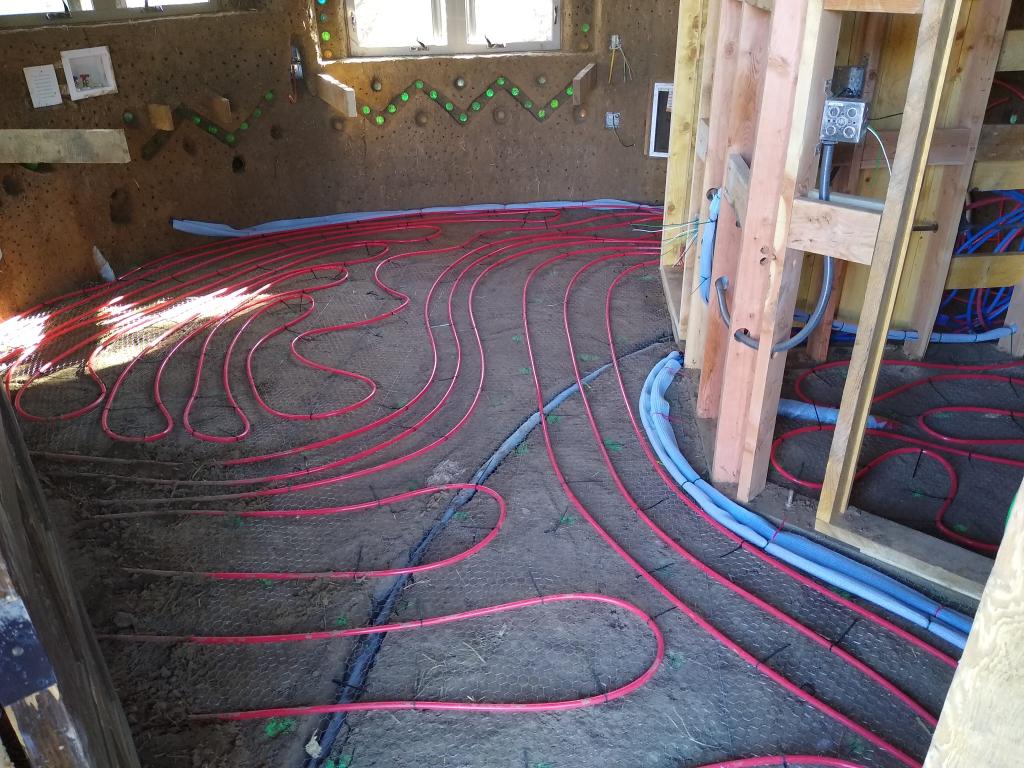
radiant heating in an earthen floor
Earthen Floors & Plasters
Essentially the same material as Cob, except that soil is sifted and straw is replaced with finer fibers for a finer appearance. Depending on availability people use wood shavings, sawdust, chopped straw or especially horse manure. The latter contains resisting remnants of chewed up fibers and adds a certain stickiness and rodent protection to the walls. Earthen floors and plasters are usually applied as a wetter mix so they can better connect with the underlying structure and be smoothed out with a trowel. They have the same thermal properties as Cob so in colder climates they can be combined with a radiant floor or wall heating and store and radiate heat over a long time.
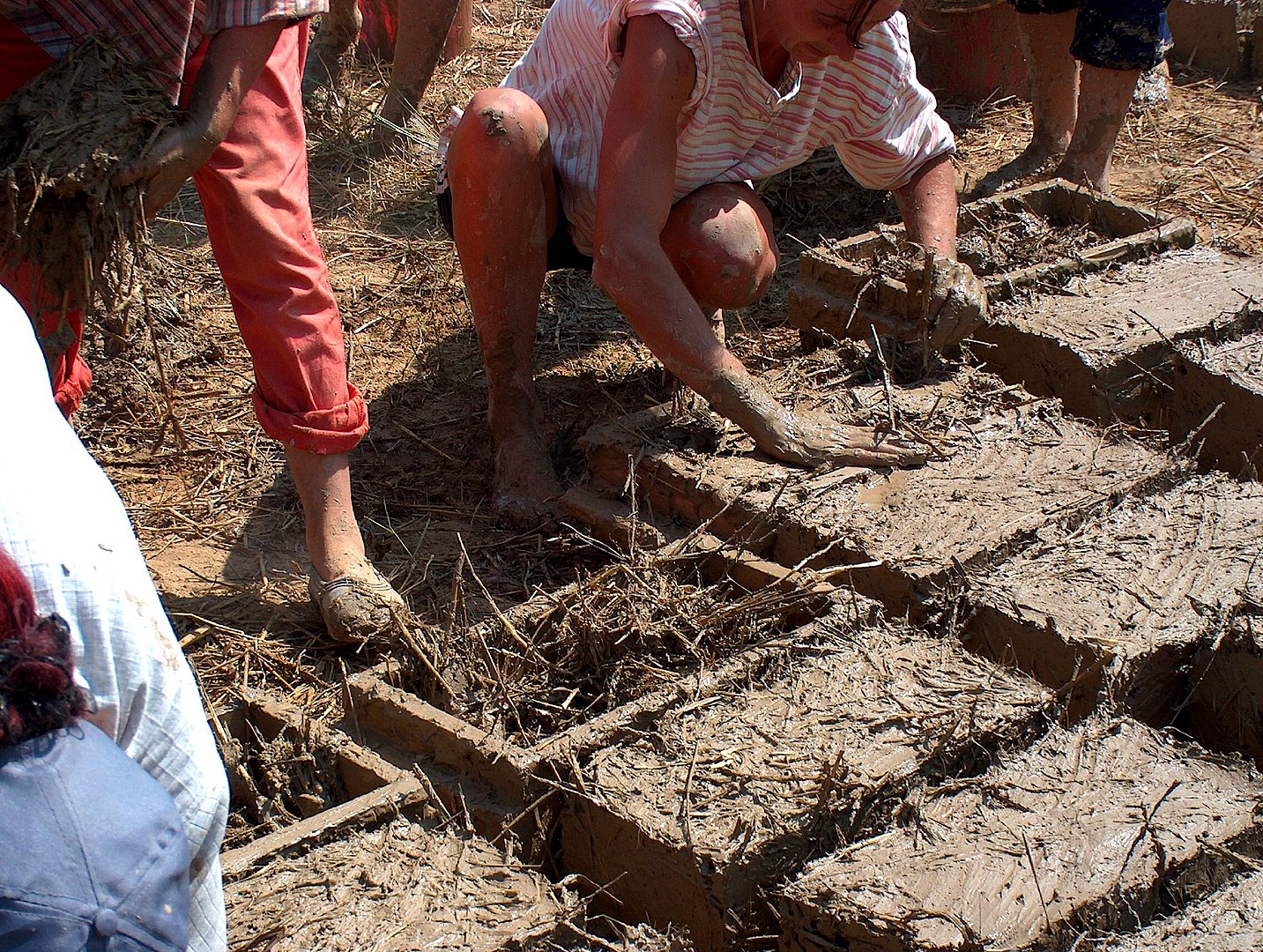
making adobe bricks
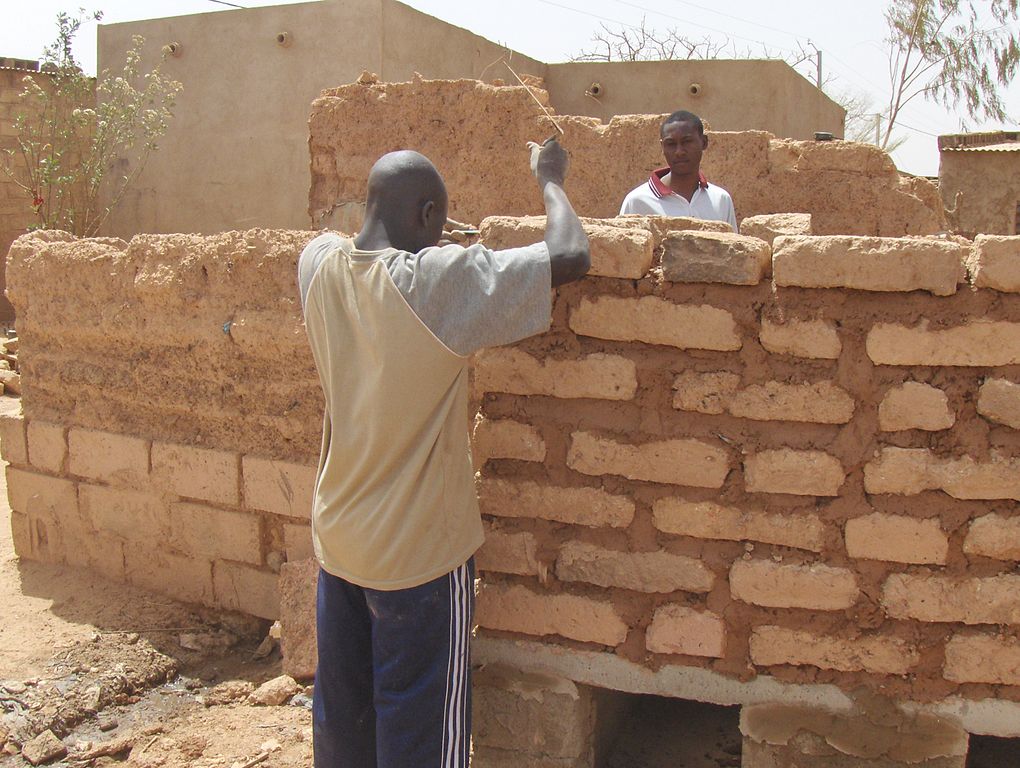
adobe wall with clay mortar
Adobe
Adobe is essentially the same material as Cob, but made into bricks via wooden forms and dried before application. These ‘mud bricks’ are not burnt like regular bricks, which maintains the ‘breathing’ property of Cob. By connecting the adobe bricks with the mortar made from the same material, the whole structure has the same thermal mass as a Cob wall. An advantage of adobe bricks is that, once they are made, they are as easy and fast to stack into a wall as regular bricks. This way a wall can be built a lot faster than with Cob, where the material has to dry and settle while building on top of it. A disadvantage is that there is no more monolithic, earthquake resistant, structure.
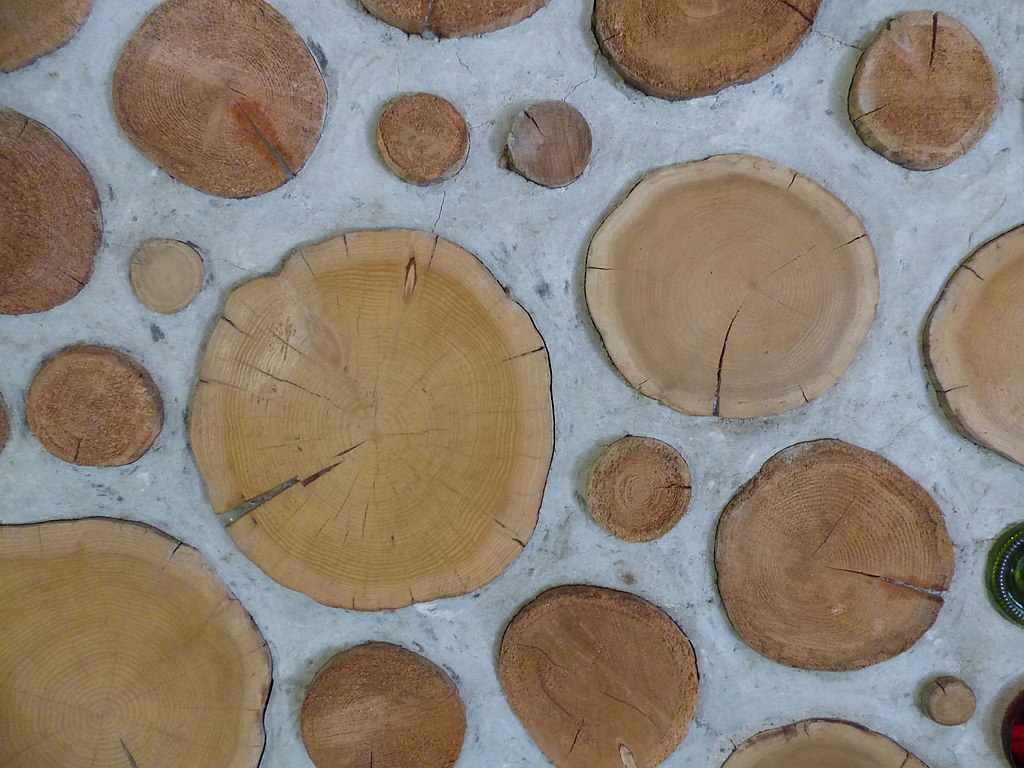
cordwood masonry in cement wall
Cordwood Masonry ( stackwood )
Cordwood masonry or simply ‘Cordwood’ was common in areas with a lot of forests, where wood is an abundant resource. Wood is cut in equally long logs, and used like bricks with cement or Cob as mortar. These walls are usually not used to bear roof loads, but only to fill in wooden frame walls. Due to different contraction and expansion of wood and mortar when exposed to moisture, there are often cracks and cavities that weaken the structure and allow rodents to nest. The most porous butt-ends exposed to the elements tend to rot and capillary perpendicular to the wall will transport moisture into the building. Therefore we recommend to use this technique rather for interior walls or to seal the wood on the outside and protect it with a protruding eave and moisture barrier to avoid absorption from the mortar.
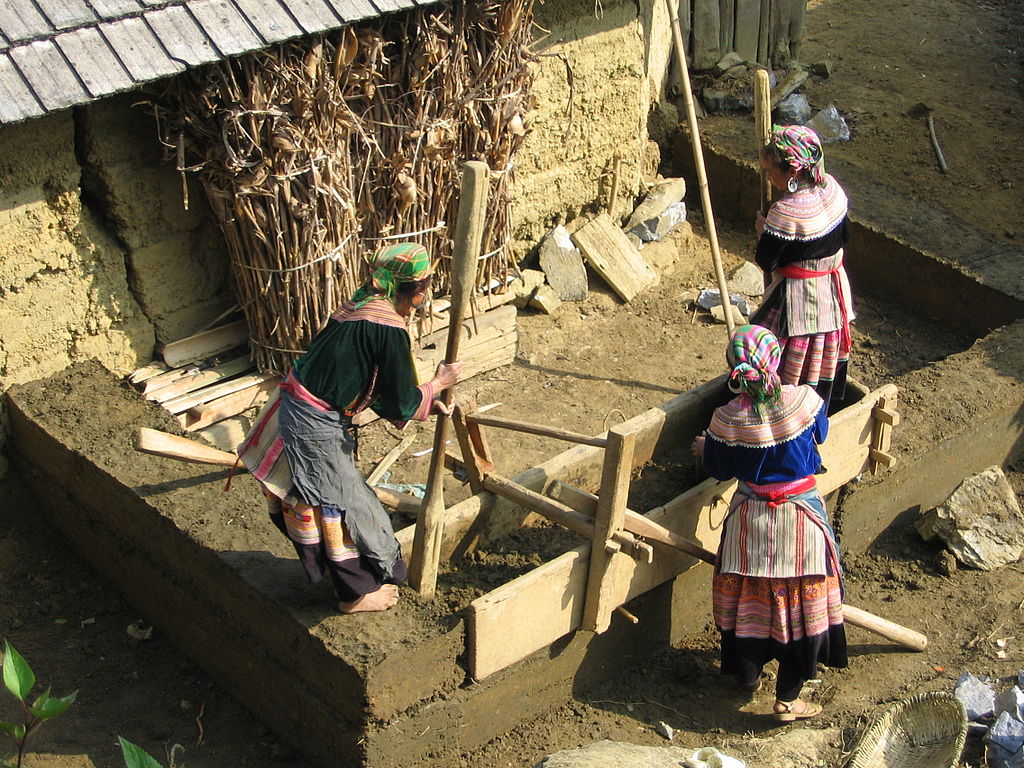
building a rammed earth wall
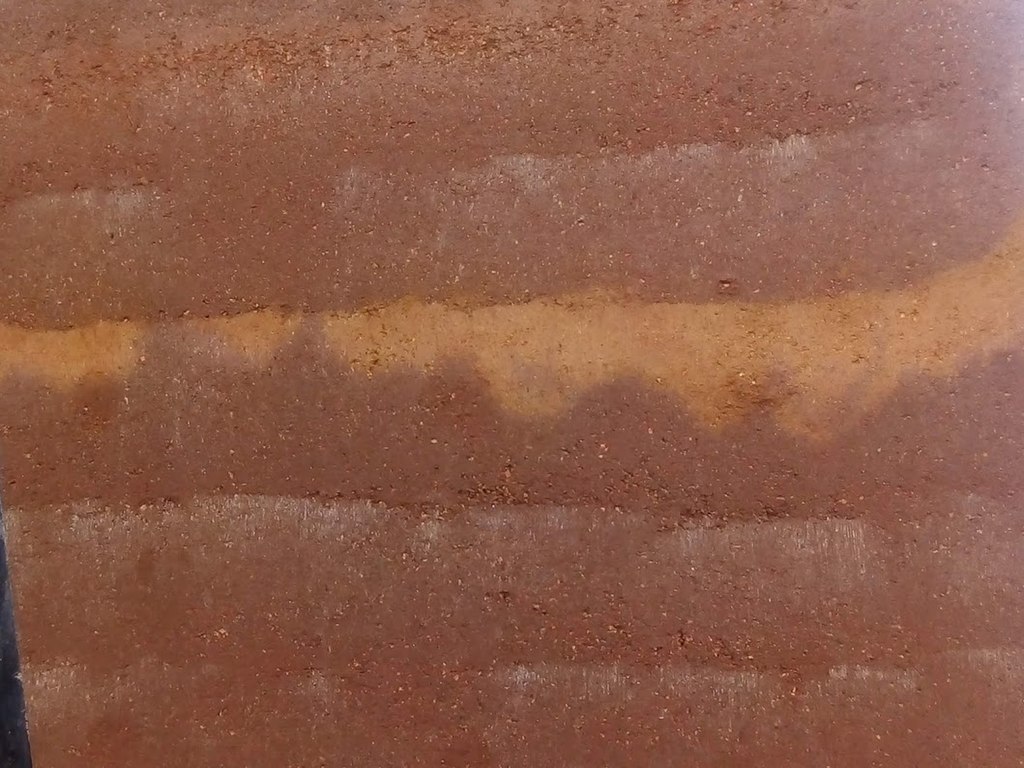
finished rammed earth wall, with changing soil pigmentation
Rammed Earth ( Stampflehm / Taipa / Pisé / hangtu / 夯土 )
Rammed Earth is one of the oldest techniques in this collection, dating back thousands of years ago, even parts of the Great Wall of China have been built this way. Like with cement the first thing is to set up forms around the perimeter of the wall to be built. Then a damp soil mixture like the one used for Cob, sometimes reinforced with lime or cement, is added in layers and tamped. The tamping can be done manually with tampers and sledgehammers or machine aided with a pneumatic hammer. The tamped soil eventually becomes something similar to sedimentary rock and looks and feels like bare cement walls. When exterior these walls, like Cob, are susceptible to rain and need to be protected with a lime finish or a protruding eave.
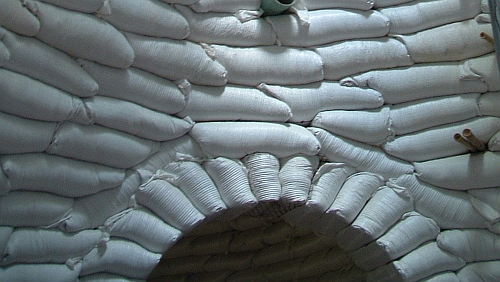
earthbag dome inside, unplastered
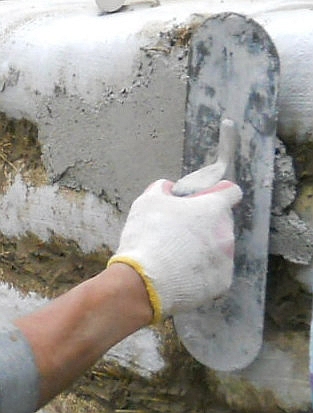
plastering earthbag
Earthbag
Earthbag is essentially the same as Rammed Earth, with the difference that the soil mix is filled into polypropylene or jute bags. These bags replace the wooden form and are stacked and connected with barbed wire and rebars. The bags are UV-unstable so they must be plastered for protection and to keep their form. Earthbags can easily shaped into domes and arches, but without a roof the outside plaster has to be especially well done for rain protection.
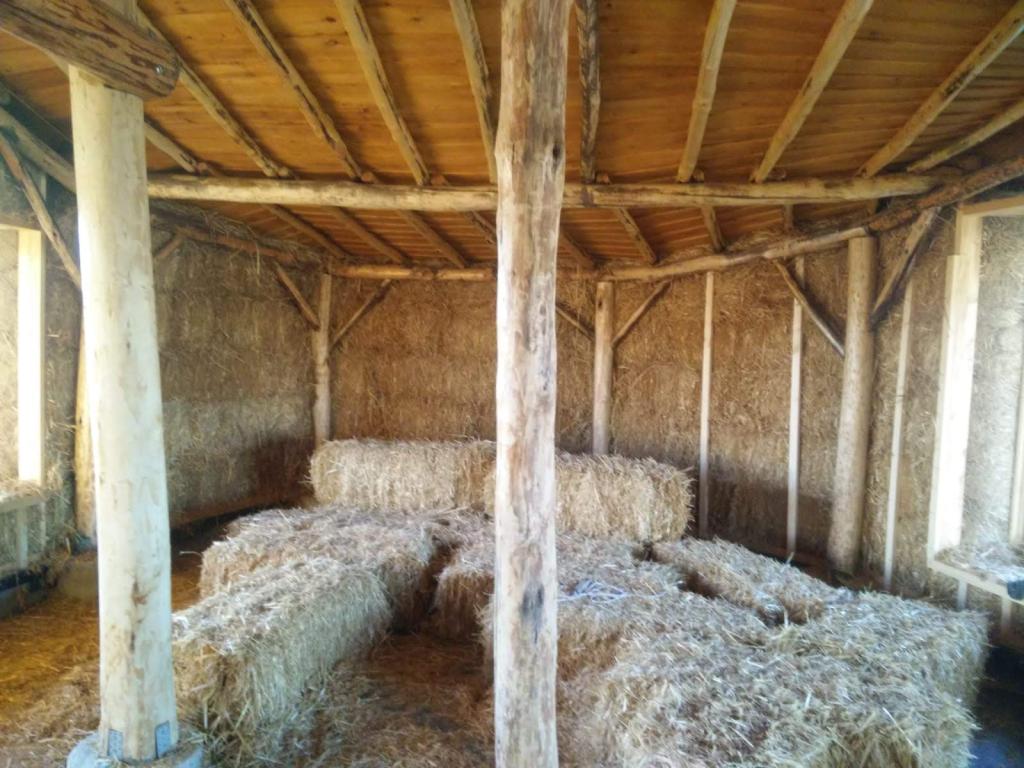
straw bale walls, unplastered
Straw bale
Straw bale walls are the opposite of earthen walls, with little thermal mass, therefore superior insulation. In locations with moderate summers and cold winters there is not enough sun to heat a cold massive wall. This is were Straw bales excel by keeping the temperature inside constant, low by day, high by night. Straw bales can be used as airtight wrapping or infill for a wooden frame or even as load bearing structure. Critical to this kind of system is moisture control to prevent rotting of the straw. A high foundation must elevate the bales off the ground and long eaves reduce rainwater hitting the wall. A multi-layered clay plaster is protecting the straw from air and absorbs moisture inside the wall to release it outside.
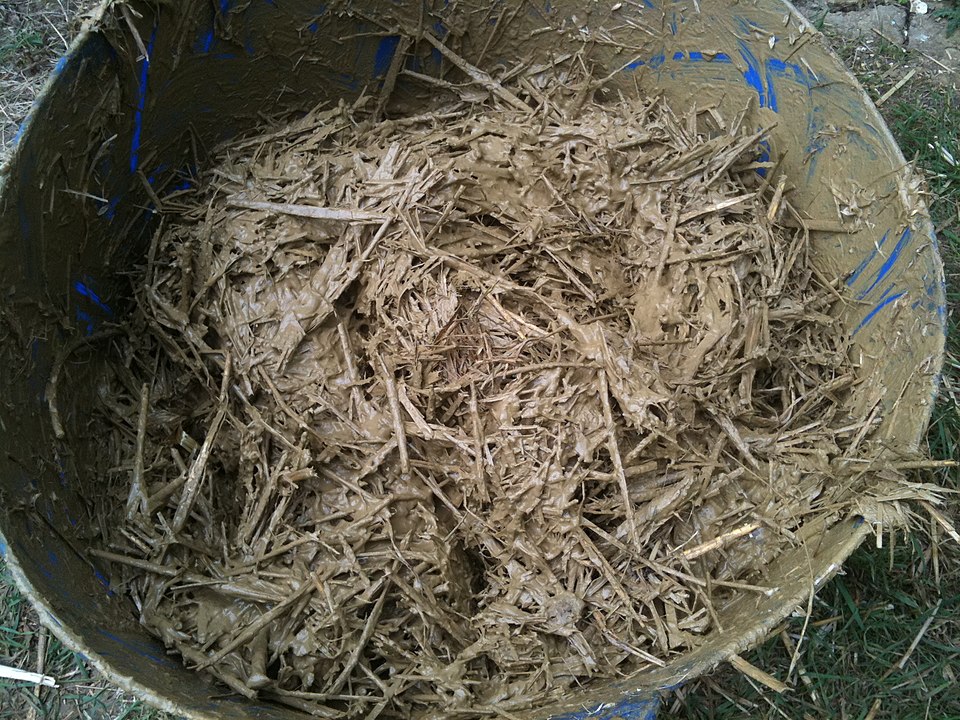
light straw clay mix
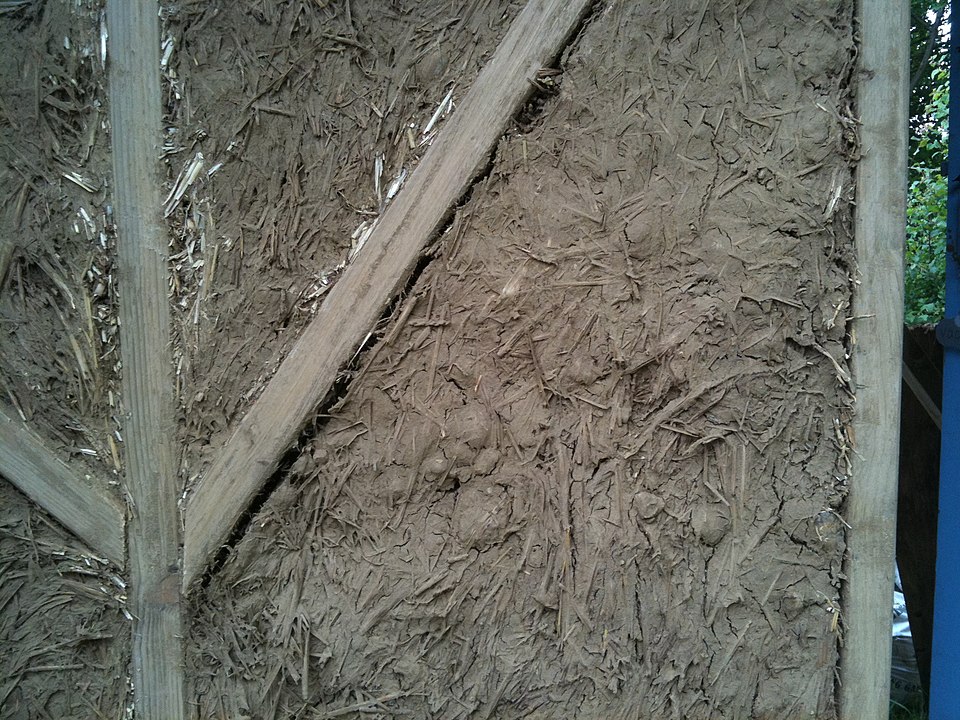
light straw clay infill
Light-Straw-Clay
Light-Straw-Clay walls, as the name says, are very light because they consist only of loose straw, covered with clay slip. Unlike the before mentioned systems Light-Straw-Clay is not load bearing, so it needs a wooden frame structure to support it. Light-Straw-Clay has good sound absorbing as well as insulating properties and is very quick to build. Like with rammed earth, you start with forms around the wooden frame, then add and lightly tamp the Light-Straw-Clay mix. You can remove the forms and plaster shortly after, depending on weather and humidity. The plaster on this kind of wall needs to be well done, because of the transitions between wood and Light-Straw-Clay. Those transitions tend to crack the plaster because of the different extension and contraction of the materials through humidity.
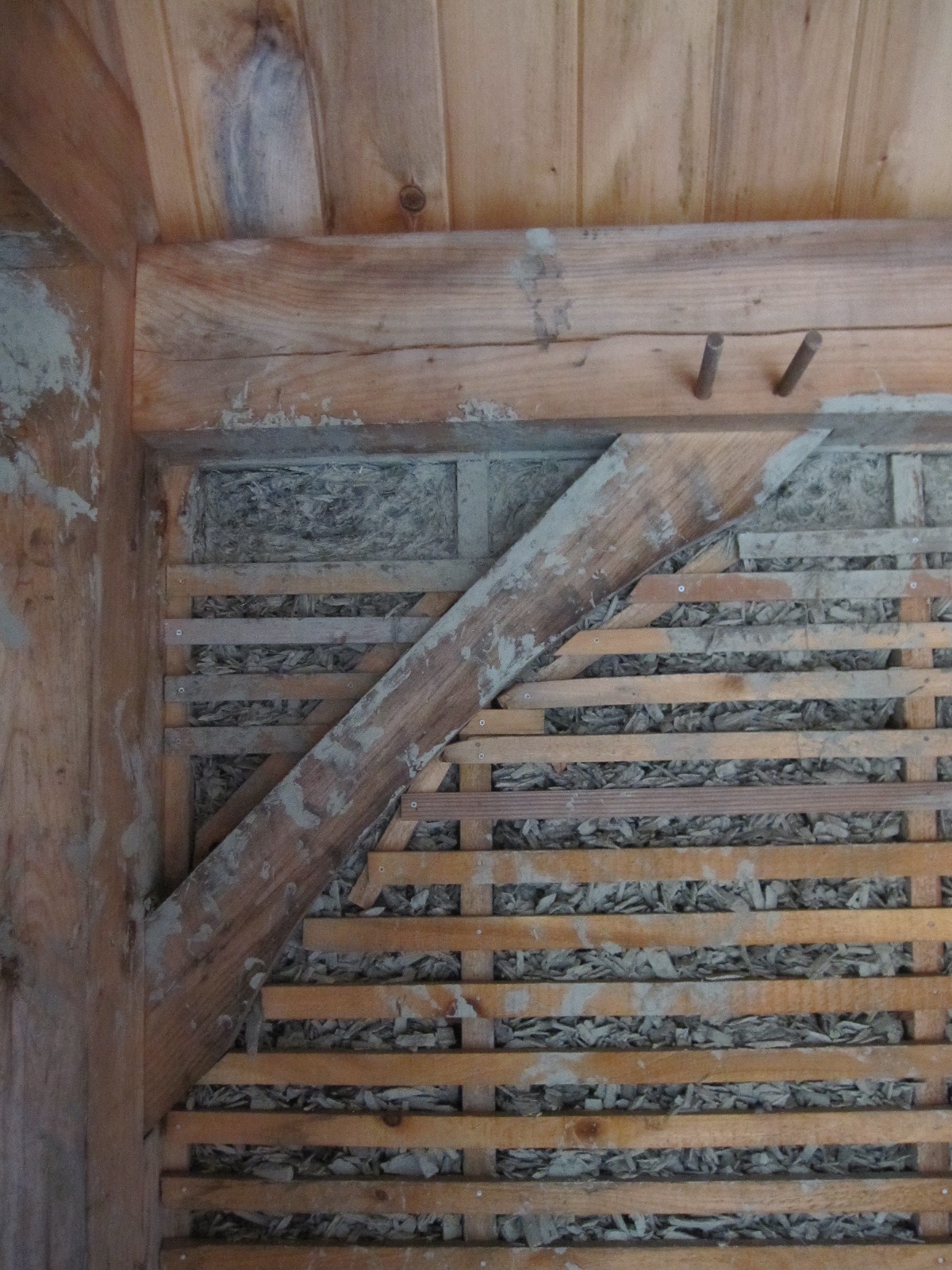
light woodchip clay infill
Light-Woodchip-Clay
Light-Woodchip-Clay is similar to Light-Straw-Clay but uses wood chips instead of straw. Therefore there is less drying time, shrinkage and because of that less labor for fixing cracks involved.
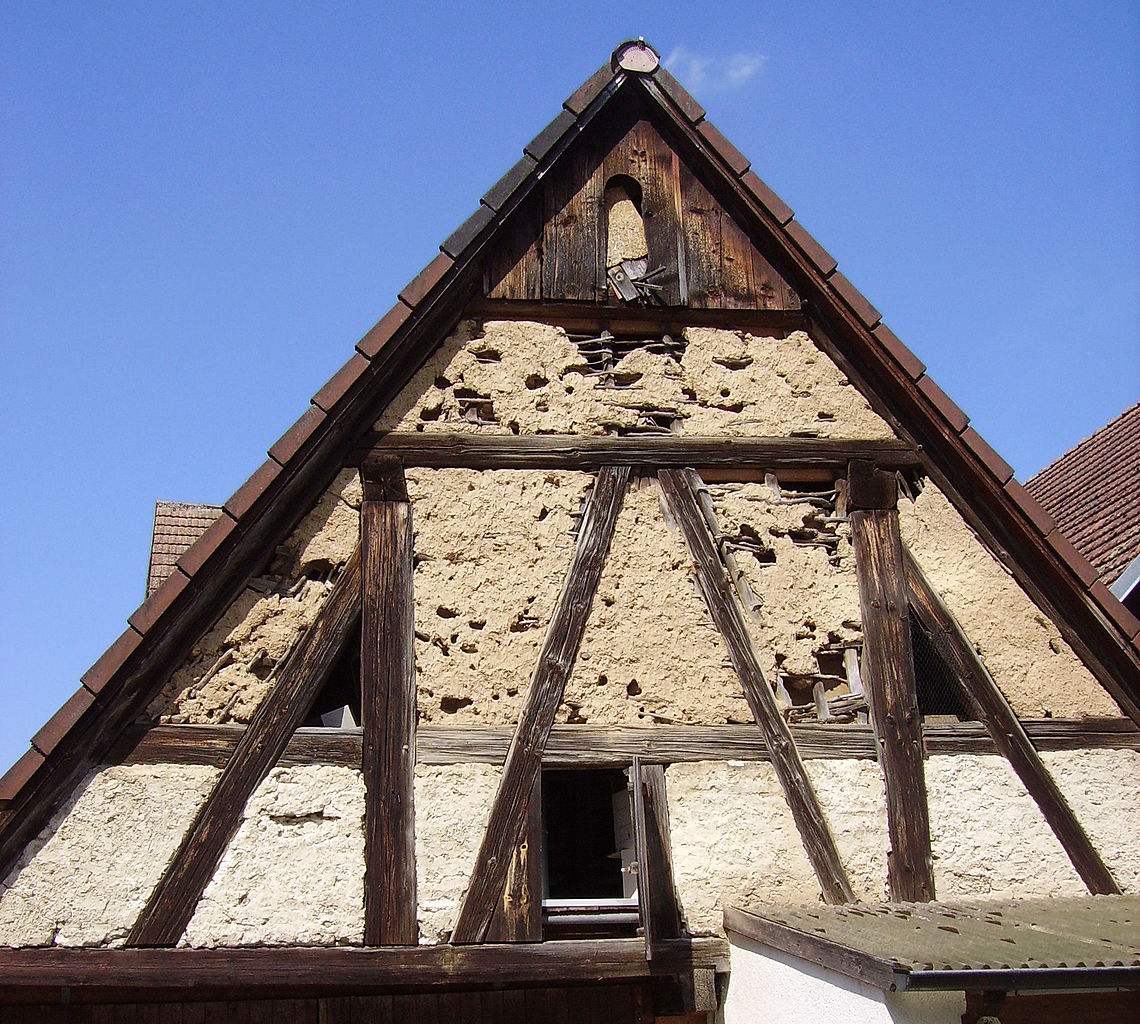
weathered wattle and daub infill from the 18th century
Wattle & Daub
Wattle & Daub is a lightweight variant of a thermal mass infill. With this technique you apply the earthen plaster (‘daub’) onto a wall of woven reed or bamboo sticks (‘wattle’). This kind of wall is quickly built, but provides very little insulation, sound absorption and thermal mass. While seen as an outside wall in this picture, we recommend it only as inside wall. This wall will absorb and radiate warmth from room to room fairly quick compared to techniques described above. Use it ideally to separate frequently used rooms like kitchen and living room.
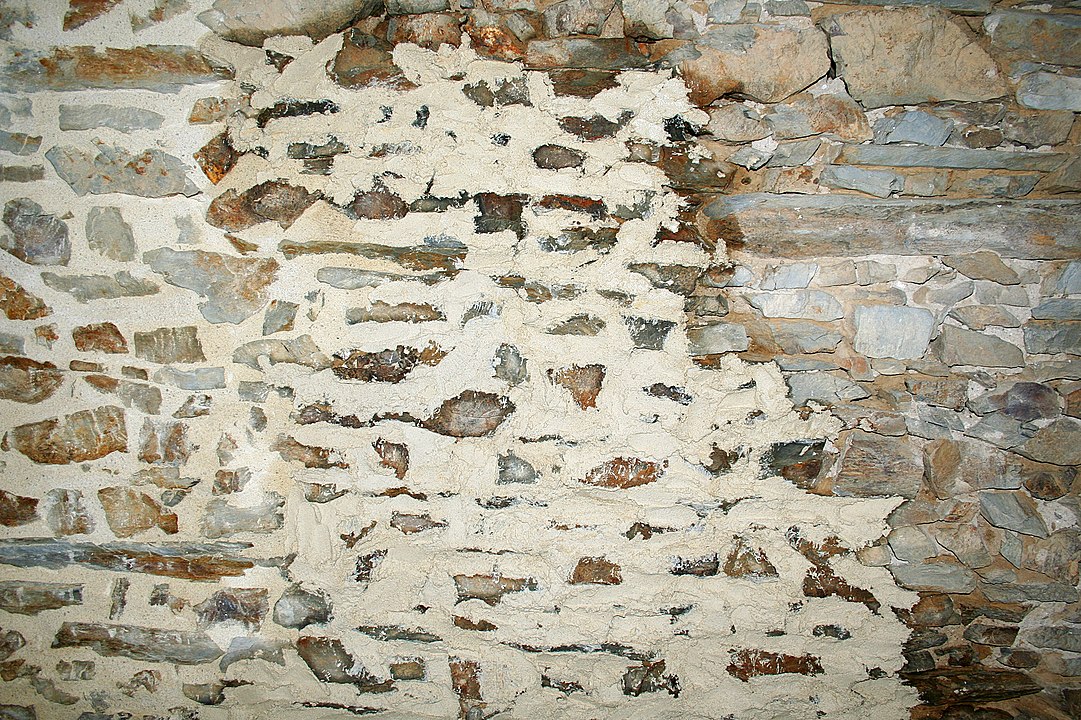
lime plaster application on a natural rock wall, rough and brushed
Natural Hydraulic Lime (NHL)
Before the Portland Cement commonly used today, we used hydraulic lime for mortar and foundations, dating back to 7500 BC. Except for compressive and adhesive strength we almost always prefer hydraulic lime to Portland Cement in Natural Building. This is due to following reasons:
- Hydraulic lime is less dense than concrete, therefore it’s less of a thermal bridge.
- Hydraulic lime permeable and can ‘breathe’ like clay.
- Micro-cracks will heal itself by salt in the air crystallizing in it and CO2 being absorbed until complete curing.
- Combined with the longer curing time this makes lime an ideal mortar for foundations supporting earthen walls like Cob/Adobe. This allows plastering while the walls are not fully dried yet and still settles when the roof goes on.
- When applied as exterior plaster it will protect clay and straw bale walls from rain, while allowing the walls to breathe. This prevents rotting and disintegrating through water trapped inside the wall.
- Due to its high pH value, lime acts as a fungicide and prevents mold from growing on the plaster.
- Hydraulic lime has a lower burning temperature of 825 °C compared to 1400 °C for Portland Cement. By this it produces 20% less CO2 emission during production.
- Until fully cured hydraulic lime ‘carbonates’ and absorbs CO2 worth 50% – 75% of its own weight from the atmosphere.
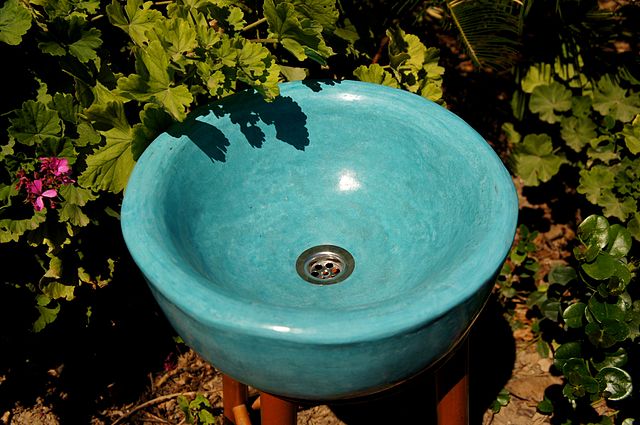
tadelakt basin
Tadelakt
Tadelakt is an ancient Moroccan technique that is sealing lime plastered surfaces to make it waterproof. It has traditionally be used in Hammam bath houses or even on roofs. The process requires several steps of burnishing and polishing with smooth river rocks. Part of the process is to apply soap onto lime plaster which makes it carbonate faster and thereby waterproof. The finish can be shiny or matte and is seamless.
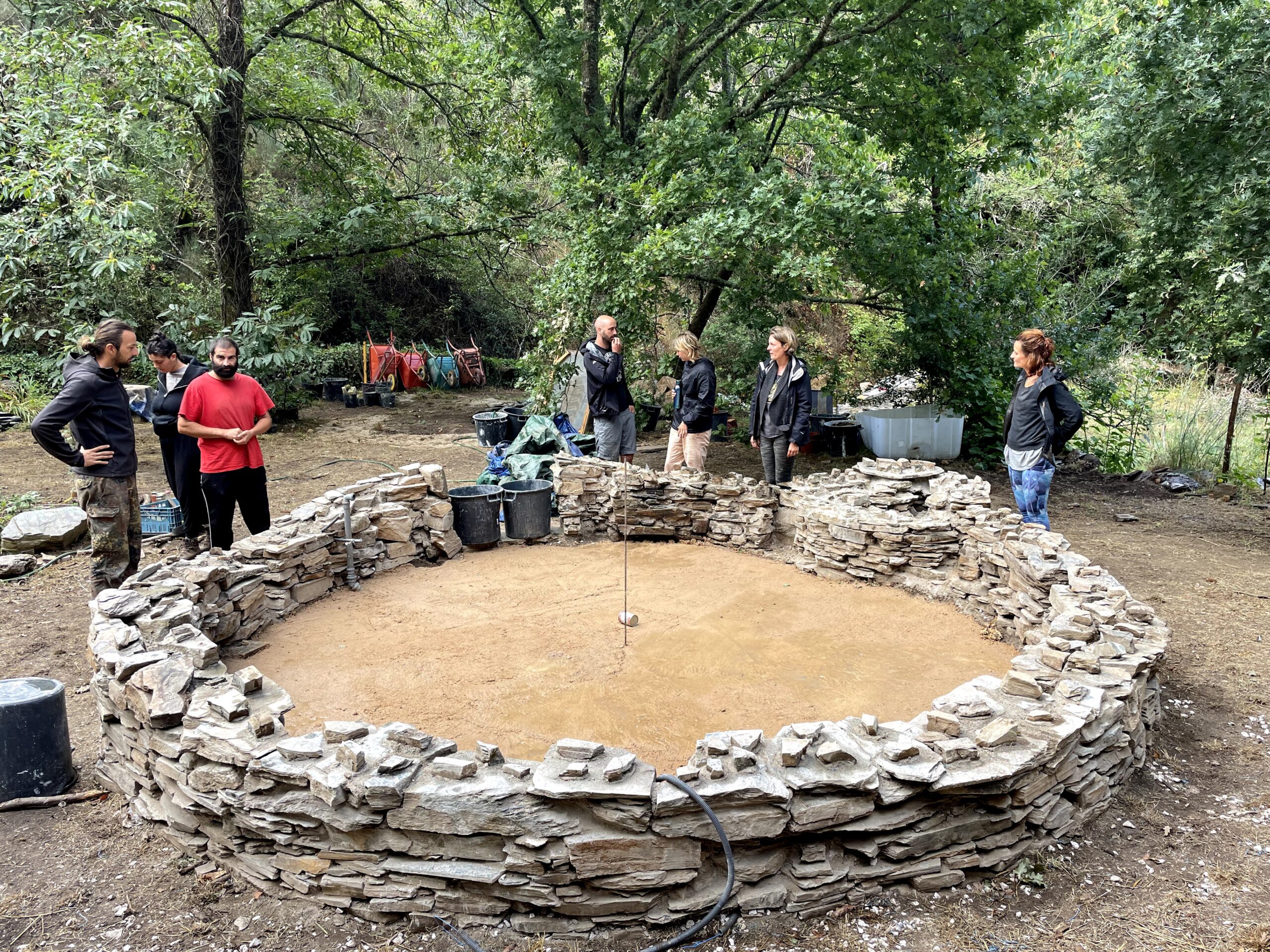
natural rock foundation with earthen subfloor
Stone
Natural rock foundations are the ideal complement for clay walls to protect them from moisture from the ground or rainwater splash. To us they look more compelling than concrete and complement the round forms that clay allows for. Stacking them the right way, however is time consuming. Due to their density they are thermal bridges that need to be insulated.
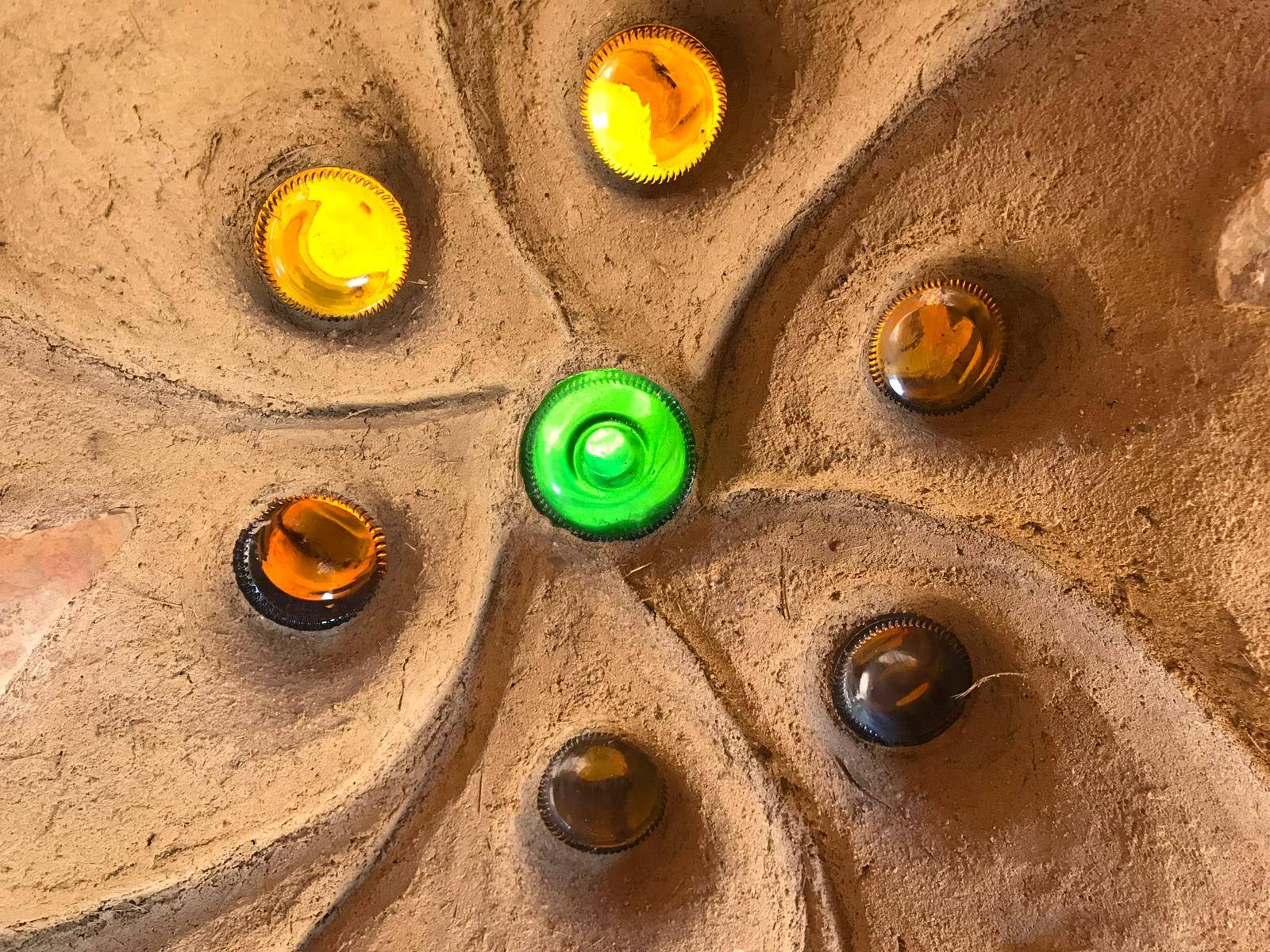
a cob sculpture with bottle brick details
Bottle Bricks / Can Bricks
Whether as volume saver, insulation or design element, bottles and cans can be recycled in many ways in Natural Building. As volume saver they can speed up your build, because you need less Cob or Strawbales and fill the space in the walls with bottles instead. Doing this you also create air pockets inside the wall, which gives you insulation and less thermal mass in case of Cob. The thing we like to use it for is as design element though, because they can really be an amazing detail in a hand-sculpted house.
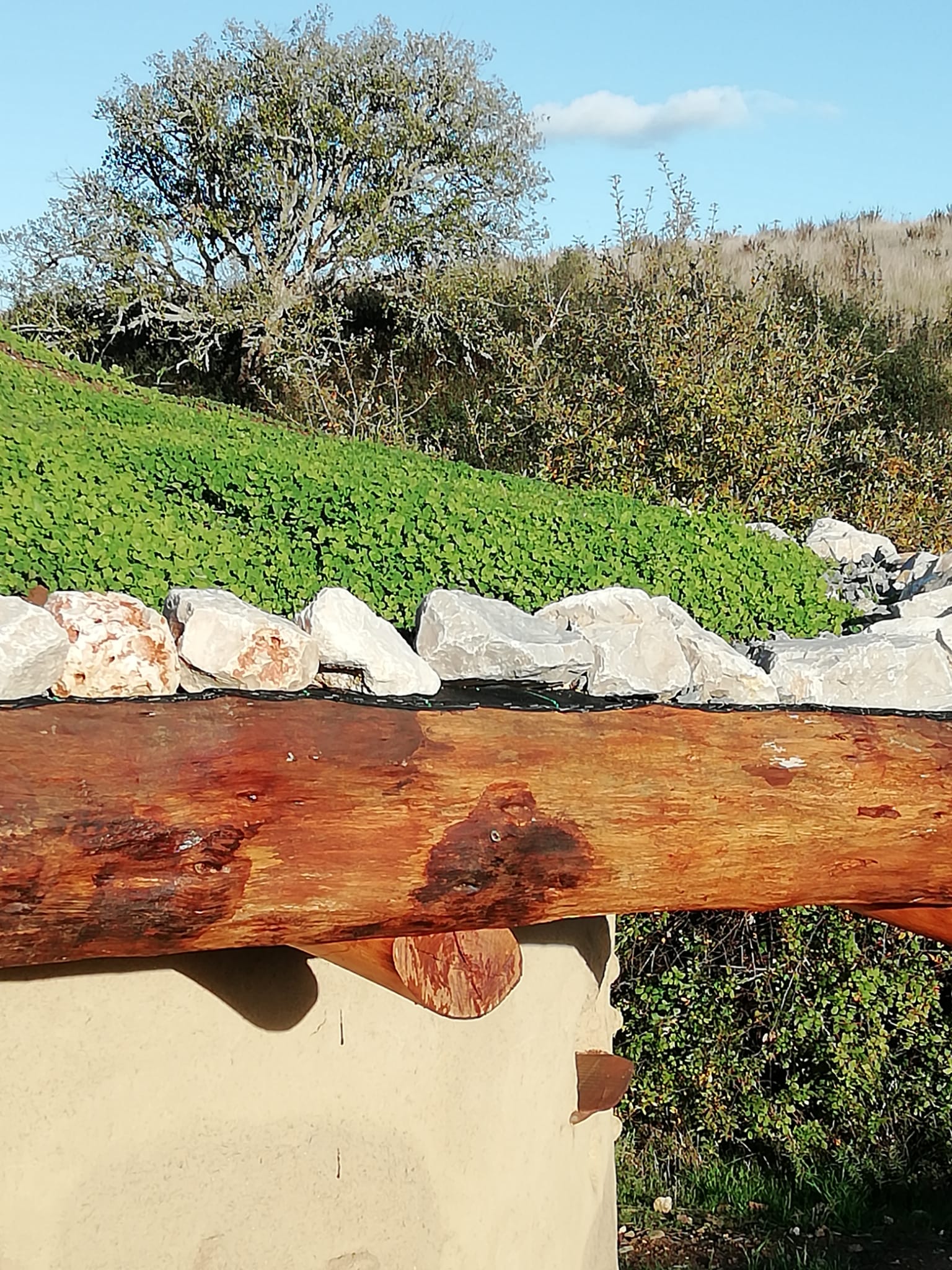
intensive green roof on a Cob cabin
Green Roofs
Unless you want to collect rain water for drinking, green roofs are another beautiful complement to earthen walls. They can be built shallow / extensive with shallow rooting grasses or plants, which needs little to no maintenance. With an intensive green roof, there is more soil and more weight on the roof, but it allows for deeper roots of bushes or vegetable plants. The soil on the roof also acts as a thermal mass, so the roof keeps the house cool during the day and warm by night. Snow on the other hand will keep the roof cold all day, so colder climates need additional insulation.
Earthships
Earthships, are intended to be sustainable houses, designed to be off grid. Rainwater is collected over metal roofs into a big cistern, filtered and usable as drinking water. Gray water is again filtered and recycled for greenhouse grey water planters and toilet flushing. Ultimately Black water is forwarded into an outside sewage tank and a leech field that feeds outside non edible plants. Sun in trapped inside an attached green house and warms inside thermal mass walls to generate a comfortable interior climate. If necessary, ventilation tubes underground bring cold air into the building. The attached green house can also produce food and contributes to a healthy humidity level inside the house. Energy is harvested from solar panels on the roof and often electrical appliances inside are operated on 24V to avoid the loss when converting to higher voltages.
Their walls are constructed with disposed of tires that would otherwise end up as landfill, often reinforced by concrete to make them more durable. To us it is a questionable practice to take likely toxic garbage from a landfill, spread it around and build it into the walls and foundations that surround us every day and let our food grow next to it. Then call it carbon neutral but reinforcing it with cement doesn’t add up for us. Instead we build PermaHomes.
PermaHomes
A PermaHome is a house that is constructed with the principles of Permaculture in mind. One that you made with your own hands, can be proud of without second thought and call home. That includes:
- Passive solar design
Sun oriented glazing and shading, thermal mass, passive venting. - Natural construction materials
Earth, strawbales, earthen & lime plasters, round pole timber frame, natural rock foundations and walls. - Water harvesting & waste reuse
Water tanks, compost toilets, greywater planters and reedbeds. - Biotecture
The manipulation of tree form to grow structures and buildings. - Earth sheltered construction
Designs that build into the ground to use earth as insulation or heat storage and integrate into their surroundings. - Natural disaster resistant construction
Bushfire, wind, flood & earthquake-proof designs and materials. - Owner building
Empowerment and financial autonomy of residents and communities in constructing their own housing using accessible technologies and materials. - Pattern Language
Organic design theory and tools of Christopher Alexander.
Insulation & Thermal Mass
Conventional building mostly cares about insulation and preventing all exchanges of heat from inside and outside the house. As mentioned in several of the technologies above thermal mass is another central concept in natural building. With earthen walls and floors we try to capture heat over the day and release it to the inside at night. Considering cold seasons where the sun radiation is less intensive and shorter this thermal storage could also be negative. With fewer daylight the wall will be cooler and work against your heating system. Therefore we like or mix in straw bale walls insulating the walls facing away from the sun. Where ever sun touches the inside or outside walls and floors, those should be earthen though. Depending on climate, thermal mass walls will keep the heat outside, or inside trapped by windows.
Embodied Carbon
When we want to save earth from the environmental crisis we have to reduce our carbon emissions. One big emitter is the building industry, mainly through manufacturing and transporting cement and chopping down wood. All of the industrial building materials that are in use today have created carbon emissions before you even get it. That is the production of the tools harvesting / mining it, as well as the vehicles transporting it. Often those materials are transported long distances which requires additional fuel.
Natural Building prefers natural, abundant and locally sourced materials as well as recycling materials from demolished buildings. Even better, the straw we use for insulation or structural strength in cob takes carbon out of the air and stores it inside the walls. Therefore we can even reach negative carbon emissions with Natural Building.
Longevity
While concrete will last for ages, even when exposed to the elements, earthen walls are just unprocessed earth. This means when without roof, they will washed away by rain over time, so that nothing will be left. Furthermore, because there are no added chemicals you don’t need to worry about disposal of toxic materials. On the other hand soil will not degrade if properly protected from rain. There are cob buildings at the coast of England that are hundreds of years old and still standing. The straw inside Cob is protected from oxidation and like new when you break down a Cob wall. One time we recycled Adobe bricks that were over a hundred years old to a base layer of earthen floor.
Cost vs. Labor
The uncomfortable truth about Natural Building is its labor intensity. There is a reason why burned bricks and quickly curing Portland Cement are so successful, its cost of labor reduced by pre-manufactured materials and ease of use requiring less skill in application.
Natural Building takes time, a lot. Cob requires controlled mixing in small batches to get a durable composition, as well as slow and incremental application and shaping. Straw bales are quickly stacked but need extra work for compression, moisture protection and plastering. Rammed Earth requires setting up forms and time consuming tamping. Hydraulic Lime needs longer to cure before you can build on top of it. When you want to hire professionals, you need to search hard, because there are not a lot of people who know how to do it anymore / yet. A shortage in skillful professionals also means they are not cheap.
The good thing though is that lime and clay are very forgiving due to their long curing time. You can always revert mistakes with earth by wetting it or brush off excess hydraulic lime on a natural rock foundation the next day. This makes it easy for amateurs to just start and do a major part of the construction by themselves, so the only thing you might need is approval of inspectors if you want to build by code. And what is better than saying you built your house with your own hands?

